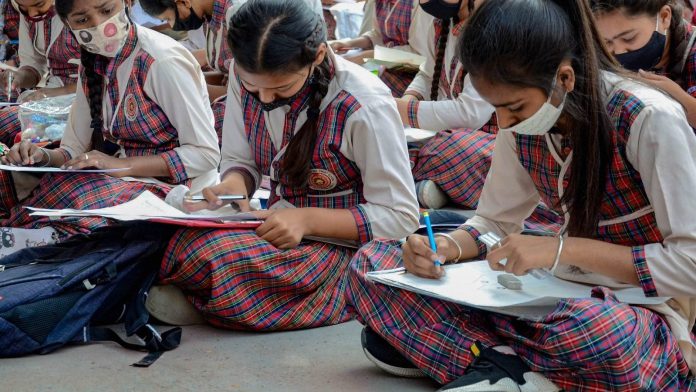[ad_1]
While the Aam Aadmi Party (AAP) does not shy away from boasting about the infrastructural and other developments in the Delhi school, a large section of Delhi government school teachers is claiming to be burnt out. The high enrolment of students in Delhi government schools has led to alarming Pupil Teacher Ratios (PTR). Further, the addition of several new curriculums and programmes has left both students and teachers overburdened.
Abiding by teachers’ claims, the National Commission for Protection of Child Rights (NCPCR) has added that their ground survey has shown that the Delhi government is violating both children’s and teachers’ rights in schools, and despite the commission’s multiple letters to Delhi government, the government continues to have a lackadaisical approach.
As per UDISE 2020-21, Delhi has 1027 schools run by the state government and 8,05,522 children are enrolled in these schools from pre-primary to elementary level.
Read | 9.93 Lakh Aspirants, 83,000 Spots: Can Hybrid Learning Heal India’s Medical College Seat Crunch?
According to the Right to Education Act 2009, the pupil-teacher ratio should be 30:1 — or one teacher for every 30 students — at the primary level and 35:1 at the upper primary level. In Delhi, the student-teacher ratio was 32.7:1 at the primary level. While this was already worse than the suggested numbers, matters got worse due to the pandemic.
Speaking to News18, Praveen Upadhayay, a school teacher at a government school said, “The teacher-student ratio in most government schools of the city has always been worrisome, however, the condition now is horrible.”
He added, after the covid-19 pandemic, student enrolment in government schools has increased as many parents moved their children from private to government schools, due to financial constraints.
“While the student’s strength has increased multiple folds, the teacher numbers are still the same, which has worsened the teacher-student ratio, especially in primary sections. In some schools in the city, there is one teacher for more than 50 students. This is not just affected the quality of education, but has also burdened the teachers,” claims Upadhayay.
Schools Running Headless
Teachers also claim that many schools in the city are functioning headless, due to vacant posts of principals and vice principals. Recent data from the Delhi Directorate of Education (DoE) data states that out of a total of 950 sanctioned posts for principals, only 154 have been filled which takes the vacant percentage to 83.7.
As of now, most of these schools are headed by vice-principals. Meanwhile, around 34 per cent of vice principal posts are vacant too. The recent DEO data also states that there are over 65,000 sanctioned posts for teachers which are yet to be filled. In an attempt to fill or reduce the gap, over 20,000 guest teachers have been appointed.
Lack of Manpower for Experimental Curricula
Lalitha, another school teacher, said, “The problem of lack of teachers and principal posts is prevailing in scores of government schools of the national capital. To add to woes, the government has started multiple experimental curricula from the Happy curriculum to ‘Deshbhakti’. But who is going to teach these, when there is a severe lack of teachers in schools? Every month there is some or the other new curriculum for both students and teachers, the government has made children its guinea pigs, and is now doing experiments on them.”
General Secretary of Government School Teachers Association Ajay Veer Yadav, said, “There is a lack of manpower in government schools and a teacher is expected to do multiple roles from administrative work to babu’s work. This has left teachers burnt out, and eventually will impact the quality of education in schools. We demand the government to take serious note of these issues.”
Meanwhile, the National Commission for Protection of Child Rights (NCPCR), chief Priyank Kanoongo told News18, “We have also found out that there is a lack of teachers in the many government schools. Instead of permanent teachers, most schools are running on guest lecturers, who do not even get the proper training to educate the pupils.”
The National Achievement Survey (NAS) 2021 for Class 8 was conducted by the National Council of Educational Research and Training (NCERT) which has found that Delhi has scored below the national average for subjects including Maths, science, and social science.
“We have written to the Delhi government multiple times to address the lack of teachers issue and another host of issues, but apart from a diplomatic official answer, we have not seen any concrete response,” he added.
Read all the Latest Education News and Breaking News here
[ad_2]
Source link

